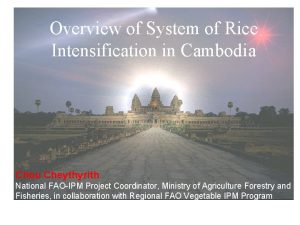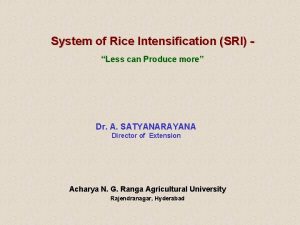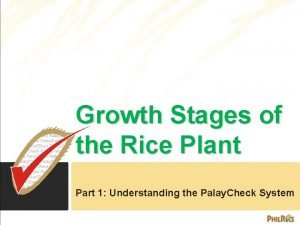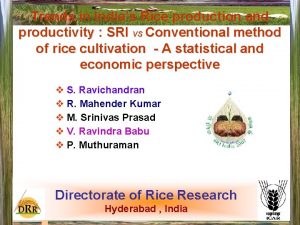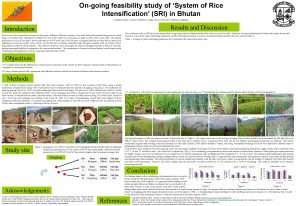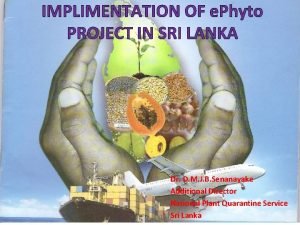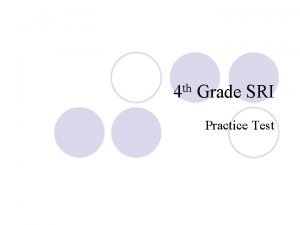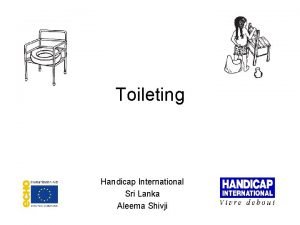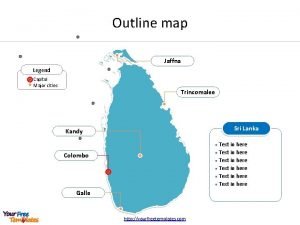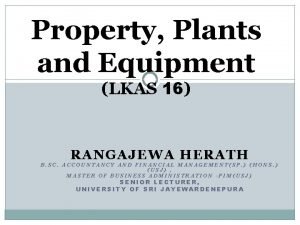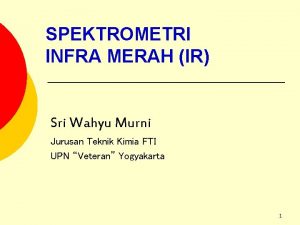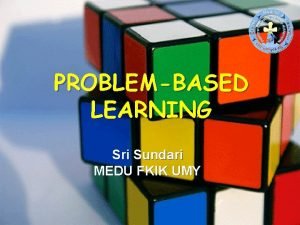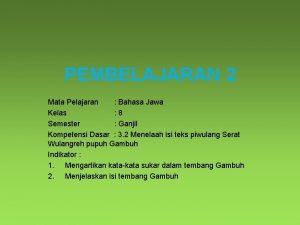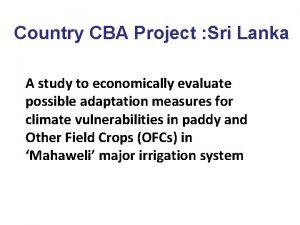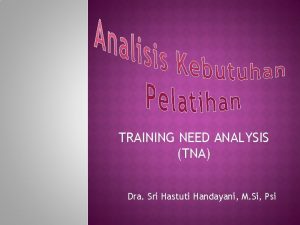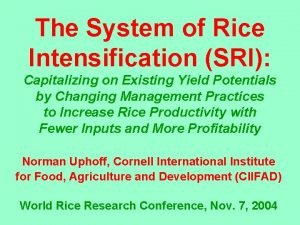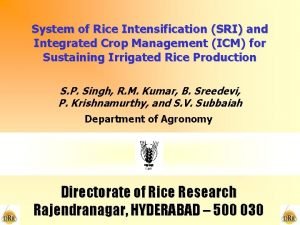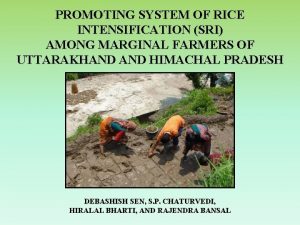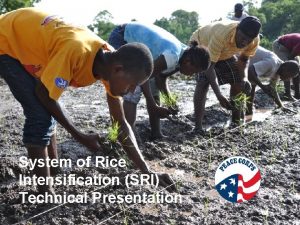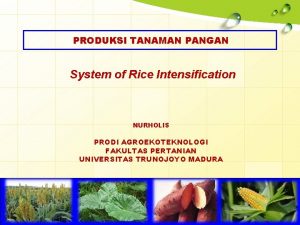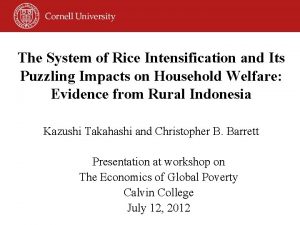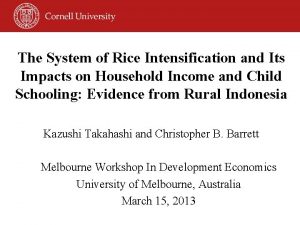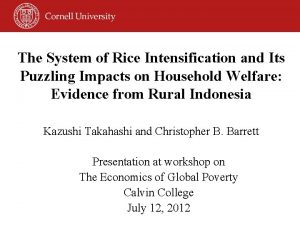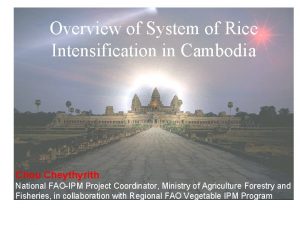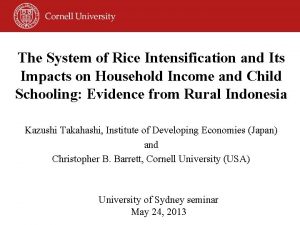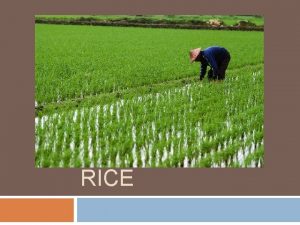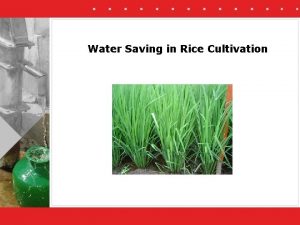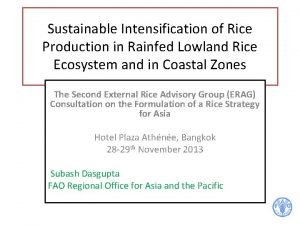System of Rice Intensification SRI rice selfsufficiency on
























































































- Slides: 88

System of Rice Intensification (SRI): rice self-sufficiency on a silver platter By Roberto Verzola Coordinator, SRI Pilipinas rverzola@gn. apc. org 0917 -811 -7747

Outline of Presentation 1. The rice plant’s capacity to produce tillers 2. The world record in rice yield 3. The “secret” of SRI 4. Bad practices inhibit tillering 5. The seven SRI practices 6. Why should DA adopt SRI?

1. The rice plant has a natural capacity to produce many tillers






2. SRI sets world record: 406 cavans/ha (India, Nov. 2011) Indian officials have confirmed five farmers' claims of beating the rice yield world record of 19 tons/ha previously held by Yuan Long-ping of China. All five farmers used the System of Rice Intensification (SRI). Of the five, Sumant Kumar reported the highest dryweight yield as verified by Bihar State agriculture officials: 20. 3 tons/ha (406 cavans), a new world record. (Phil. Star, Dec. 18, 2011, p. B-4).

. . . to beat a world-famous scientist's world record in rice yield Sumant Kumar of India shows off his record-setting rice plants

Five ordinary farmers use SRI for only three years. . . Sumant Kumar (center) is honored by Bihar's Chief Minister (left)

SRI sets world record in rice yield: 406 cavans/ha (India, Nov. 2011)

SRI sets world record in rice yield: 406 cavans/ha (India, Nov. 2011)

SRI sets world record in rice yield: 406 cavans/ha (India, Nov. 2011)

SRI sets world record in rice yield: 406 cavans/ha (India, Nov. 2011)

SRI sets world record in rice yield: 406 cavans/ha (India, Nov. 2011)

Significance of the SRI world record With SRI, farmers can do better than scientists. Philrice, IRRI can't get 400 cavans Great results within a few seasons. Farmers broke the world record 3 yrs after learning SRI results are not “tsamba”. Not one but five farmers equalled/exceeded the world record. Do not expect to get 400 cavans yourself! This is a world record, like Pacquiao's 8 crowns.

SRI advocate gets 2012 RM award SRI advocate in Cambodia, Dr. Yang Saing Koma. Convinced the govt to support SRI. In 8 years, they were able to double Cambodia's rice production from 3. 8 M tons (2002) to 7. 8 M tons (2010). Dr. Koma is one of the 2012 Ramon Magsaysay awardees.

SRI first timer in Laur, NE gets 338 cavans/hectare Dr. Joey Tolentino is a “weekend farmer” with 6 hectares of rice land in Laur, Nueva Ecija In Jan 2013, he tried organic SRI for the first time in 1, 035 sqm, using an Indonesian inbred In the rest of his farm, he used a hybrid variety and the recommended chemical methods. He got 338 cavans/ha with SRI (35 cavans from 1, 035 sqm), 80 cavans/ha from the rest.

3. The “secret” of SRI To get a high yield, farmers must learn to grow more tillers

System of Rice Intensification (SRI) Under SRI, the rice plant can express once more its natural capacity to produce many tillers




Growing more tillers: the phyllochron theory of tillering Phyllochron: the time interval separating the onset of two successive leaves on the same tiller (de Laulanie, 1992) (4 -5 days in Philippine lowlands)

The theory of the phyllochron Seedling stage Days after germination First phyllochron 4 -5 days (first leaf) 2 nd phyllochron 8 -10 days (second leaf) 3 rd phyllochron 12 -15 days (third leaf) 4 th phyllochron 16 -20 days (fourth leaf)










If you want 84 tillers, your variety Short- or long-maturity seeds? needs 115 days or more to mature Seedling stage: ~15 days Tillering stage: N days Reprod. stage: 65 days Total: 80+N tillering days 95 -day varieties: 80+15 tillering days (P 7: 8 t) 105 -day varieties: 80+25 tillering days (P 9: 21 t) 115 -day varieties: t) 80+35 tillering days (P 12: 84

Why do farmers get very few tillers? Every rice plant has a natural capacity to produce many tillers. Some farmers' practices inhibit this natural tillering capacity

4. Bad practices that inhibit tillering Late transplanting Maltreatment of seedlings Too little space for each seedling Too much competition from weeds Continuous flooding; no dry period Poisoning soil organisms with chemicals

4 th leaf (16 -20 days)

Late transplanting disrupts tillering Tillering starts on the 4 -leaf stage (16 -20 DAS) If transplanting is done when tillering is about to start, or has already started, tillering is delayed or aborted. If delayed: there's little time left for tillering If aborted: whatever number of tillers the transplanted seedlings had, that's it! The SRI way: transplant two-leaf seedlings





Maltreatment disrupts tillering Seedlings are like babies, but they are often treated very badly during transplanting Rough treatment of seedlings that are about to tiller will delay or abort tillering The SRI way: transplant seedlings as if you are moving a baby from the crib to the bed, without waking it up, hurting it, or causing any injury

Transplanting: like moving a baby from the crib to the bed

Maltreated seedlings: Leaves cut in half, strangled bodies

Maltreated seedlings: amputated roots, strangled bodies

Amputated leaves, roots

Maltreated seedlings: Amputated leaves, roots

Maltreated seedlings on a torture rack

Maltreated seedlings: Thrown into the field

Maltreatedseedlings: Hands and roots feet cut leaves cutoff

Maltreatedseedlings: Interwoven roots willneed havetotobe becut Interwoven roots

Giving tender care: Tenderseedlings loving care: 2 -3 loving cm average 2. 5 cmdistance avg distance between seeds

Tender loving care: getting Getting seedlings from the seedbed Bumunot Dumukot ng punla sa ng lupa sa punlaan

Giving tender loving care: Tenderseedlings loving care: getting seedbed soil with seedlings on them



Planting in clumps inhibits tillering When they are planted in clumps, plants do not get enough sunlight and nutrients There is not enough space for tillering The plants use up their energy in competing with neighbors instead of growing grain The SRI way: 1 seedling per hill, 25 x 25 cm between hills


Planting clumps results in one (or more) weak, sickly plant per hill If you plant 2 or more seedlings per hill, every hill will have a weak and sickly plant A weak and sickly plant attracts pests and disease

At least one will be weak and sickly

The SRI way: 1 seedling per hill, 25 The x 25 Method cm or more

Weak, shallow roots inhibit tillering When fields are always flooded, the roots do not get enough oxygen and they die slowly Since water is always available, the roots have no reason to grow thickly or deeply Sparse, shallow roots cannot support many tillers The SRI way: alternate wetting and drying (2 -3 days wet; 5 -7 days dry)

Alternate wetting and drying results in thicker, deeper roots Wet soil Dry soil

The white roots are healthy, the dark roots are dying

White roots are healthy



Allowing weeds to compete with rice If weeds are allowed a headstart, they will compete with the rice plants for sunlight, food, and space Weeds are the biggest problem under the SRI method, and farmers cannot become good at SRI until they master how to control weeds. The SRI way: temporary flooding, manual weeding, mechanical weeding, ducks





Using chemicals that poison soil organisms Chemicals (commercial fertilizers, pesticides, herbicides, fungicides, molluscides, etc. ) harm soil organisms. These organisms are the true source of plant nutrients. Reduce their population and you are forced to rely more on synthetic fertilizers The SRI way: use lots of organic matter (in the first season, 1 bag of compost per 100 sqm)

100 bags/hectare of vermicompost (mined-out area): 6. 5 tons/ha palay

By putting 10 tons of vermicast and spraying NFS concoctions (IMO, FPJ, etc. ) weekly on two hectares of mined-out fields, VSU agricultural technologist Juanito Poliquit harvested 260 cavans of palay in 2011.

5. The SRI way Younger (2 -leaf) seedlings, for faster recovery Careful transplanting, to avoid root damage 1 plant per hill, wider distances (25 x 25 cm), to minimize competition between plants Intermittent wetting and drying, to aerate the soil and encourage deeper root growth Rotary weeding for soil aeration, weed control Lots of compost, to bring back soil organisms

Non-SRI The Result

Your first SRI trial Convince some friends, neighbors to try too Start with a small plot: 100 -500 sqm Land prep: as much compost as you can afford Several varieties on separate sub-plots Sow sparsely: 1 inch (2 -3 cm) between seeds Exclude skeptical, stubborn transplanters

Land Preparation Use lots (and lots!) of compost/organic matter As much as your target yield Spread these into the field as early as possible Compost/organic fertilizers are slow-acting Keep the fields as level as possible Weeds: let them sprout, then kill them Snails: dig canals inside, around each plot

Seed selection Prepare 100 g of seeds per 100 sqm of trial plot Prepare a pail of salt water Use sea water or add salt to fresh water until a fresh egg will float on it Dunk the seeds into the water Discard the seeds that float, use those that sink Wash the good seeds in fresh water to remove all salt

Seedbed preparation Use 1 sqm of seedbed per 100 sqm of trial plot For seedbed, use 50% good soil, 50% compost You may also add carbonized rice hull (CRH) Average distance between seeds: 1 -2 cm The roots of neighboring seedlings should NOT intertwine Transplant on 2 -leaf seedlings (8 -12 DAS)

Transplanting The field should be level, but not flooded (drain the field the night before transplanting) Mark the field with a 25 x 25 cm grid pattern With one hand, get from the seedbed a piece of soil; seedlings should be undisturbed in the soil In the field, take a clump of soil with just one seedling, and gently transplant it into the mud Like moving a baby from the crib, to the bed.

After transplanting Snail control: Immediately after transplanting, broadcast 2. 5 kg of goat manure per 100 sqm plot (to suppress snails) Avoid flooding the field for the next two weeks Weed control: Use a rotary weeder as soon as weeds appear Weed again every 7 -10 days, to delay weed growth Do not let the weeds gain momentum

Water management Irrigated Flood the field for 2 -3 days Dry the field for 5 -7 days Repeat wet/dry cycle every 7 -10 days Observe the seedlings for stress! Rain-fed Follow nature's own wet/dry cycle Do not flood continuously

6. DA: Why should it adopt SRI? Help farmers shift to organic farming, high yield offsets the yield drop during the organic transition Climate change mitigation: lower water and fertilizer use reduce methane, CO 2 emissions CC adaptation: sturdy stalks, deep roots make plants more resilient vs typhoons, floods, droughts For the poor: SRI is good for poor farmers, who need to borrow less thanks to lower costs; debt-free farming As Plan B, in case main program fails
 Sri system of rice intensification
Sri system of rice intensification Sri system of rice intensification
Sri system of rice intensification Sri system of rice intensification
Sri system of rice intensification Rice plant growth stages
Rice plant growth stages Hemasankari
Hemasankari Sri rama sri rama sri manoharama
Sri rama sri rama sri manoharama System of rice intensification
System of rice intensification Rapid intensification
Rapid intensification Western intensification
Western intensification Process intensification example
Process intensification example Payment and settlement system in sri lanka
Payment and settlement system in sri lanka Lanka settle system
Lanka settle system Payment and settlement system in sri lanka
Payment and settlement system in sri lanka Sri lanka tsunami warning system
Sri lanka tsunami warning system How to calculate vat in sri lanka
How to calculate vat in sri lanka Tiep sri lanka customs
Tiep sri lanka customs How long is the reading inventory test
How long is the reading inventory test Food and beverage industry in sri lanka
Food and beverage industry in sri lanka Sri vasavi ca charitable trust
Sri vasavi ca charitable trust Gaura-bhakta-vrinda meaning
Gaura-bhakta-vrinda meaning Seismometer in sri lanka
Seismometer in sri lanka Reading counts levels
Reading counts levels Kementerian pendidikan kuala lumpur
Kementerian pendidikan kuala lumpur Digital literacy in sri lanka 2021
Digital literacy in sri lanka 2021 Phytosanitary certificate sample
Phytosanitary certificate sample Finance commission of sri lanka
Finance commission of sri lanka Sri zaheer
Sri zaheer Ecommerce website in sri lanka
Ecommerce website in sri lanka Sri harti widyastuti uny
Sri harti widyastuti uny Disaster management centre sri lanka
Disaster management centre sri lanka Corporate governance in sri lanka
Corporate governance in sri lanka Apartment ownership law no 11 of 1973
Apartment ownership law no 11 of 1973 Pqli advantages and disadvantages
Pqli advantages and disadvantages Bone marrow transplantation sri lanka
Bone marrow transplantation sri lanka The three-legged stool deals with _____.
The three-legged stool deals with _____. Sri vedantha desikar devasthanam
Sri vedantha desikar devasthanam Aleema shivji
Aleema shivji Sri mamudji
Sri mamudji Sri vasavi ca charitable trust
Sri vasavi ca charitable trust Sri vasavi ca charitable trust
Sri vasavi ca charitable trust Courseweb.sliit.lk
Courseweb.sliit.lk Sri krsna caitanya prabhu
Sri krsna caitanya prabhu Sri aurobindo institute of culture
Sri aurobindo institute of culture Hipofisis posterior
Hipofisis posterior Rampunge cerkak manggon ana ing
Rampunge cerkak manggon ana ing Kirribath
Kirribath Map sri lanka capital
Map sri lanka capital Om sri sai ram
Om sri sai ram Om sri sai ram
Om sri sai ram Maha ravana raula
Maha ravana raula Sri lanka folk tales
Sri lanka folk tales Dun sri medan
Dun sri medan Madhwa tilak
Madhwa tilak Metric map of sri lanka
Metric map of sri lanka Endaru tree
Endaru tree Agriculture insurance in sri lanka
Agriculture insurance in sri lanka Sri lanka auditing standards
Sri lanka auditing standards Grade 11 english formal letter
Grade 11 english formal letter Organigrama sri
Organigrama sri Gaura-bhakta-vrinda meaning
Gaura-bhakta-vrinda meaning Jaya sri krishna chaitanya prabhu nityananda
Jaya sri krishna chaitanya prabhu nityananda Lkas 16 presentation in sinhala medium
Lkas 16 presentation in sinhala medium Nabc
Nabc Sri harti widyastuti uny
Sri harti widyastuti uny Maksudnya
Maksudnya Dr. danang sri hadmoko s.si. m.sc
Dr. danang sri hadmoko s.si. m.sc Mohan lal grero
Mohan lal grero Amelia sri kusuma dewi
Amelia sri kusuma dewi Sri lanka institute of information technology affiliations
Sri lanka institute of information technology affiliations Sri krishna caitanya prabhu nityananda
Sri krishna caitanya prabhu nityananda Sri wahyu c esther
Sri wahyu c esther Sri sundari umy
Sri sundari umy Materi tembang gambuh kelas 11 semester 2
Materi tembang gambuh kelas 11 semester 2 Sri parameswaran
Sri parameswaran Sri harti widyastuti uny
Sri harti widyastuti uny Sri harti widyastuti uny
Sri harti widyastuti uny Afas methyl bromide fumigation standard
Afas methyl bromide fumigation standard Formato rise
Formato rise Cba sri lanka
Cba sri lanka Sri astuti indriyati
Sri astuti indriyati Sri adiningsih fkm unair
Sri adiningsih fkm unair Sri adiningsih fkm unair
Sri adiningsih fkm unair Pathra dathuwa
Pathra dathuwa Writ jurisdiction in sri lanka
Writ jurisdiction in sri lanka Dr sri hastuti andayani
Dr sri hastuti andayani Sri lanka tea board elevation average
Sri lanka tea board elevation average Sri hastuti handayani
Sri hastuti handayani Shotokan karate sri lanka
Shotokan karate sri lanka Kongu region
Kongu region
